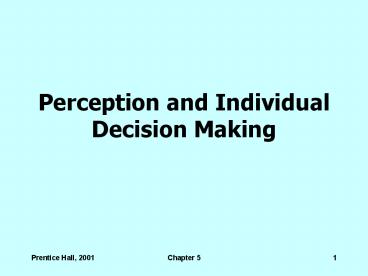Perception and Individual Decision Making - PowerPoint PPT Presentation
Title:
Perception and Individual Decision Making
Description:
Perception and Individual Decision Making Planning Horizon and Uncertainty Frequently Used Shortcuts When Judging Others Specific Applications in Organizations ... – PowerPoint PPT presentation
Number of Views:295
Avg rating:3.0/5.0
Title: Perception and Individual Decision Making
1
Perception and Individual Decision Making
2
Planning Horizon and Uncertainty
?
RISK
CERTAINTY
UNCERTAINTY
NOW
TIME
3
Factors ThatInfluence Perception
4
(No Transcript)
5
(No Transcript)
6
Specific Applications in Organizations
- Employment interview
- Performance expectations
- Performance evaluation
- Employee effort
- Employee loyalty
7
Awareness and Recognition of Problems
Perception and Individual Decision Making
Interpretation and Evaluation of Information
8
Decision-Making Process
- Identify and Define Problem
- Identify and Set Decision Criteria
- Develop List of Alternatives
- Bounded Rationality
- past experience
- time, resources
- Evaluate Alternatives
- Select Best Alternative
- Implement
- Evaluation and Feedback
9
(No Transcript)
10
Assumptions of the Model
One Problem Clarity
Four Constant Preferences
Five No Constraints
Two Known Options
Three Clear Preferences
Six Maximum Payoff
11
The Three Components of Creativity
Expertise
Creativity
Task Motivation
Creativity Skills
12
A Model of Bounded Rationality
Ascertain the Need for a Decision
Select Criteria
Identify a Limited Set of Alternatives
Compare Alternatives Against Criteria
Select the First Good Enough Choice
Yes
Simplify the Problem
Expand Search for Alternatives
A Satisficing Alternative Exists
No
13
Intuitive Decision Making
- High uncertainty levels
- Little precedent
- Hard to predictable variables
- Limited facts
- Unclear sense of direction
- Analytical data is of little use
- Several plausible alternatives
- Time constraints
14
Two Important Decision-Making Phases
15
Making Choices in the Workplace
16
Decision-Making Styles
High
Analytic
Conceptual
Tolerance for Ambiguity
Behavioral
Directive
Low
Way of Thinking
Rational
Intuitive
17
Performance Evaluation
Reward System
Organizational Constraints
Historical Precedents
Programmed Routines
18
(No Transcript)
19
Ethics in Decision-Making































